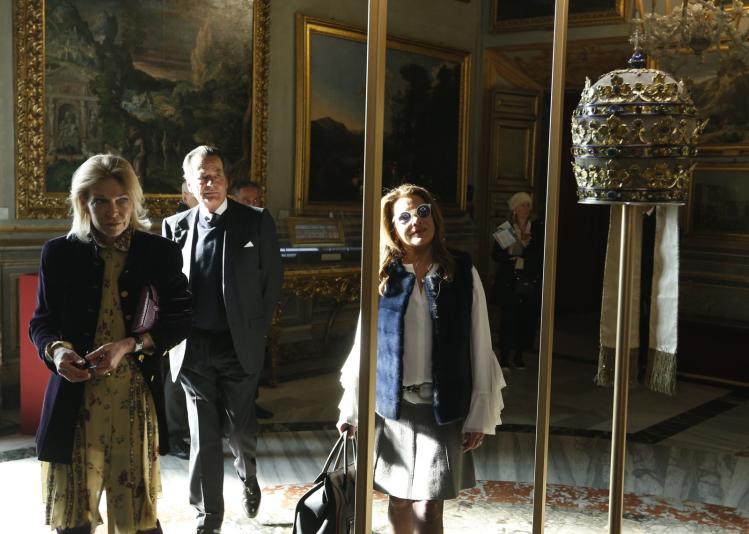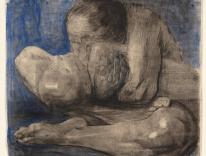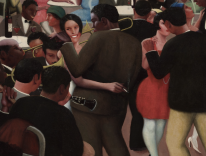
“It’s all beautiful, but it’s a shame,” a woman told me as we looked at a chalice that had belonged to Pope Leo XIII. It was an impressive object, with four gold evangelists under gothic canopies; in blue-enamel circles on its base, the papal crest was set in diamonds. Usually housed in the Sistine Chapel’s sacristy, the chalice is one of the objects on loan from the Vatican for the Metropolitan Museum of Art’s exhibit “Heavenly Bodies: Fashion and the Catholic Imagination.” It was too luxurious for my interlocutor, who thought the popes should have given that money to the poor instead of spending so lavishly on themselves: “I don’t think it’s what Jesus had in mind.”
Leo was not buying for himself, however. Nor did Pope Pius IX purchase the three tiaras in the exhibit—one containing more than nineteen thousand precious stones, the vast majority of them diamonds. Like so many of the papal objects on display, they were gifts, commissioned by towns, religious communities, and royalty. The Austrian Empress Maria Anna Carolina sent Pius IX a set of twelve vestments, with embroideries of biblical scenes and saints that have the intricacy and vitality of paintings. It took fifteen women sixteen years to make them.
The silks and jewels are all extravagant, no doubt partly motivated by a patron’s desire for prestige. But a nearby chasuble, richly embroidered with scenes from the life of St. Francis of Assisi, points to another explanation. It was made by a convent of Poor Clares, anonymous women who had given up everything to live in poverty. Their sewing was a gift of love—extravagant love. Such love lies at the heart of the Catholic imagination, though it went unremarked in the commentary on the exhibit.
The doctrines and devotions of Catholicism nurture particular and personal affections. Catholics believe that the pope is a spiritual father, that Mary is the Mother of God and our advocate, and that the faithful receive the body and blood of Jesus in the Eucharist. These beliefs inculcate feelings that run deeper than intellectual assent. They inculcate love. In the gospels, this love drove a woman to anoint Jesus’ feet with expensive perfume. The disciples ask why the money was not given to the poor, but Jesus recognizes the motivation for her extravagance. That same love appears throughout the history of Christianity. St. Francis stripped himself naked in the marketplace, but wanted his friars to carry the Eucharist in pyxes made of precious metals, since it was Christ himself. Churches throughout the world are filled with silver offerings for prayers answered, statues of the Madonna whose dresses and crowns change with the season, and jeweled chalices—many the gifts of simple believers who want to give their love the best.

“Heavenly Bodies” shows how contemporary fashion borrows aesthetic elements from Catholic devotion. We see evening dresses inspired by the habits of different religious orders—brown for Franciscans, black and white for Dominicans—or priests’ soutanes. John Galliano accessorized his episcopal evening gown with a matching miter and a thurible.
The curators discuss the way in which Catholicism and fashion are both interested in narrative and metaphor. They exhibit the contemporary fashion pieces alongside the medieval items that inspired them. But this in turn underscores the difference between the imaginations at work. Carved rosary beads served as a way for the devout to ponder death, which does not seem to be the purpose of A. F. Vandevorst’s mask of black leather straps bedecked with plastic rosaries. Jean Paul Gaultier’s “Communion” ensemble has a chalice cupping the breasts of its wearer. Gaultier intended to provoke, but late medieval artists juxtaposed the Eucharist with Mary’s breasts to emphasize that she who once fed her son now feeds Christians with the human flesh her son took from her.
Gaultier’s “Communion” is about transgression and the expression of an artist’s singular vision. A medieval painting with Mary, breasts, and the Eucharist is about the visible manifestations of personal devotion and union with God. That is the heart of the Catholic imagination, more than an interest in storytelling or a focus on particular aesthetic elements. In the world of haute couture, the cross is just an accessory. In the Catholic imagination, it is much more.
Please email comments to [email protected] and join the conversation on our Facebook page.
Previous Story
A Cinematic Civics Lesson
Next Story
A Purpose-Driven Life


